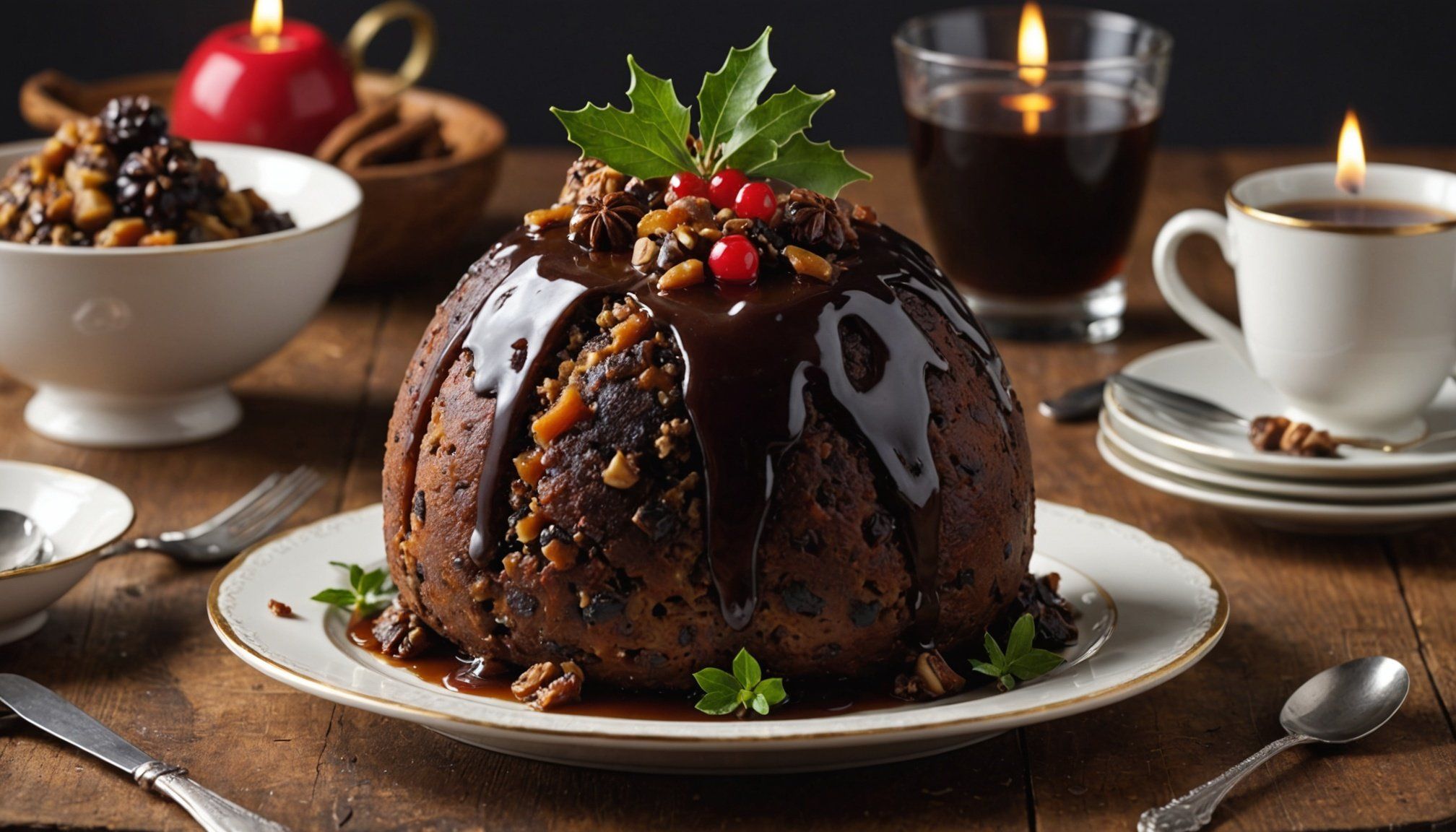Understanding the Traditional British Christmas Pudding
Known for its distinct flavour and rich history, the traditional British Christmas pudding has deep roots. Emerging around the 14th century, it was initially a porridge called “frumenty,” incorporating meats, grains, and dried fruits. By the Victorian era, it evolved to its present steamed dessert form, becoming a festive staple.
The cultural significance of Christmas pudding is embedded in customs like “Stir-Up Sunday,” when families gather to mix the ingredients. Tradition dictates that each family member takes a turn stirring the pudding while making a wish. Serving the pudding aflame and decorating it with holly further enhances its festive allure, symbolising light and renewal amid the winter darkness.
Also to see : Create the perfect crispy fish and chips at home: your ultimate guide to crafting irresistible tartar sauce
The pudding’s ingredients carry symbolic meanings; for instance, the dried fruits represent Christ’s disciples due to their number, while the spices recall the Wise Men’s gifts. Each component contributes to both the taste and tradition of this dessert.
This iconic dish embodies a blend of historical roots and festive tradition, enriching the modern Christmas celebration with its significance and depth. The evolution of the Christmas pudding ensures it remains a cherished element of British festivities.
Also read : Mastering the perfect english custard tart: insider tips and techniques unveiled!
Essential Ingredients for the Ultimate Christmas Pudding
Crafting a perfect Christmas pudding begins with selecting the right mix of traditional and modern ingredients. Quality ingredients are crucial, such as rich dark sugar and freshly milled spices, ensuring a deep and complex flavour profile. Essential components typically include dried fruits, suet, breadcrumbs, and a splash of brandy or rum for moisture and aroma. However, ingredient variations offer flexibility for various dietary needs and preferences.
Traditional vs Modern Ingredients
Traditionally, this festive dessert features currants, raisins, and sultanas, alongside suet, which is often swapped for vegetable shortening or butter in modern recipes. For those with dietary restrictions, plant-based options can replace traditional ingredients without compromising taste. For instance, almond or coconut flour can serve as a substitute for breadcrumbs, while non-dairy alternatives can replace suet.
Importance of Quality and Seasonality
Leveraging high-quality ingredients elevates your pudding from mediocre to magical. Opt for locally sourced, seasonal produce where possible, enhancing not only flavour but also sustainability. Quality liquor, whether it’s spiced rum or fine brandy, enriches the pudding and ensures it matures beautifully over time.
Experiment and personalise your recipe with innovative twists; consider adding grated apple or pear for a fresh contrast to the classic density.
Step-by-Step Guide to Preparing Christmas Pudding
Preparing the Mixture
To craft the perfect Christmas pudding, begin by assembling your ingredients. Combining dried fruits, such as raisins and currants, with brandy or rum is crucial for achieving a traditional flavour. Remember that the process includes precise preparation steps, ensuring each component blends seamlessly. Incorporate flour, breadcrumbs, and a touch of mixed spices to enhance the aroma and consistency.
Mixing and Steaming Techniques
Effective cooking techniques require thorough integration of ingredients. For optimal results, use a large mixing bowl to ensure even distribution. Once the mixture is ready, transfer it into a greased pudding basin, covering with parchment paper and foil. The steaming process, essential for retaining moisture, should extend for several hours. This method ensures the pudding cooks evenly and develops a rich texture.
Maturing the Pudding
Maturing your pudding is vital. Store the cooked pudding in a cool, dark place, allowing the flavours to deepen over time. This aging period enriches the Christmas pudding, harmonizing the taste profile. As part of the preparation steps, consider topping up the pudding with extra alcohol during maturing to further enhance its rich flavour and ensure a moist finish.
Common Pitfalls and Troubleshooting Tips
When preparing a Christmas pudding, several mistakes can frequently occur, but with some knowledge, they are easy to avoid. One common issue is using ingredients that lack freshness or quality, which can adversely impact both the texture and flavour of the pudding. Always opt for fresh, high-quality fruits and spices to enhance the overall taste.
Troubleshooting texture issues is another challenge. If your pudding turns out too dry, try adding a bit more liquid—such as brandy or orange juice—during the preparation process. Conversely, if it’s too moist, reduce the amount of liquid and ensure the mixture is properly combined before steaming.
Speaking of steaming, it’s essential to perfect this process to achieve that classic moist texture. Always ensure your pudding basin is well-sealed with a lid or foil to trap steam. Additionally, maintain a steady simmer throughout the steaming duration; boiling too rapidly can cause the pudding to toughen.
Lastly, remember to let your Christmas pudding mature. Giving it time to develop and mellow its flavours will ensure a delightful festive treat, transforming any initial missteps into an exquisite culinary experience by the time of serving.
Presentation and Serving Suggestions
Christmas pudding is a cherished tradition, but its presentation can elevate its festive appeal. For a classic touch, serve the pudding on a decorative plate, garnished with a sprig of holly. Pairing with traditional accompaniments, such as brandy butter, custard, or cream, enhances the rich flavours.
Modern serving ideas can add a fresh twist. A dusting of icing sugar over the top creates a snowy effect, while edible glitter can offer a touch of sparkle. For a more dramatic presentation, try flaming the pudding by pouring a ladle of warm brandy over it and lighting it just before serving—a theatrical flourish that never fails to impress.
Consider these festive garnishing tips:
- Flavourful fruit coulis drizzles can provide a contrast in tastes.
- Arrange sliced citrus, such as orange or clementine, around the pudding for vibrant colour and zest.
- Incorporate nuts like pistachios or almonds to add both texture and elegance.
The key to elevating the Christmas pudding lies in its balance of tradition and innovation, ensuring it looks as memorable as it tastes. By mixing classic elements with creative presentation, you can delight guests and enhance the overall dining experience.
Variations on the Traditional Christmas Pudding
Christmas pudding, a staple of holiday festivities, has seen numerous modern twists catering to diverse tastes and preferences. While the classic recipe remains beloved, contemporary adaptations explore new flavor adaptations and innovative ingredients.
Popular Variations on the Traditional Recipe
Adventurous cooks have creatively expanded beyond the traditional mix of dried fruits and nuts. Incorporating seasonal flavors such as cranberries, apples, or even citrus zest adds a refreshing tang. For those seeking a contemporary twist, chocolate-infused versions present a rich alternative, appealing to those with a sweet tooth.
Incorporating Seasonal Flavors and Ingredients
Seasonal additions such as spices like cinnamon and nutmeg are popular, enhancing the warmth associated with festive dining. Fresh ingredients like pears or dates bring a natural sweetness, aligning with current culinary trends favouring whole foods. These adjustments offer a delightful update while maintaining the heart of the dish.
Recipes for Non-Traditional Christmas Pudding Options
Innovative recipes introduce non-traditional bases, such as sponge or ice cream, allowing diverse textures and temperatures, suitable for various palates. For lighter alternatives, consider a steamed citrus pudding which offers a softer, less dense option. By embracing these adaptations, Christmas pudding remains a versatile and inviting dessert for all celebrations.
Enhancing Your Christmas Pudding Experience
A delightful Christmas pudding experience often goes beyond the pudding itself—pairing it with the right accompaniments can elevate your festive meal. Let’s explore some ideas for enriching your taste journey.
Imagine serving your pudding with a range of complementary drinks. A robust glass of port or a sherry is traditionally popular, adding warmth and depth to the sweet richness of the dessert. Alternatively, a sparkling wine can provide a crisp contrast, enhancing the flavors of the spices embedded in the pudding.
To further enhance flavors, consider adding sauces or creams. Brandy butter or custard is a classic, adding a creamy texture that effortlessly melds with the cake’s dense notes. For a contemporary twist, vanilla or cinnamon-flavored whipped creams offer a gentle sweetness that doesn’t overpower.
When planning your entire meal, think about dishes that harmonize with the unique profile of a Christmas pudding. A festive meal that includes savory flavors, like roasted meats or a sharp cheese platter, can balance the dessert’s sweetness, creating a well-rounded dining experience. By considering these pairings and enhancements, your Christmas pudding experience can transform from simple to spectacular.









